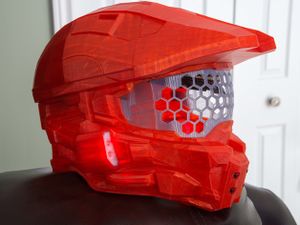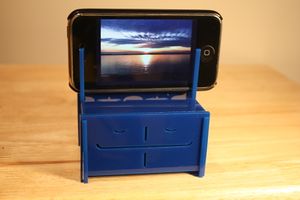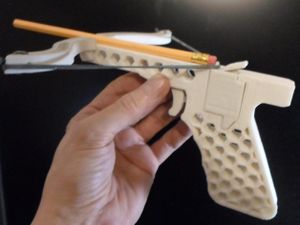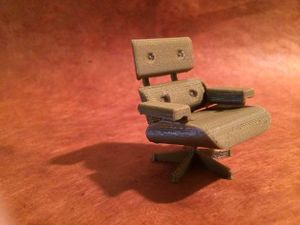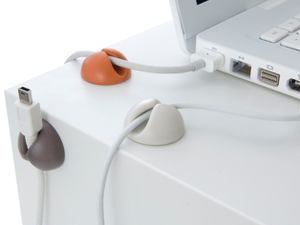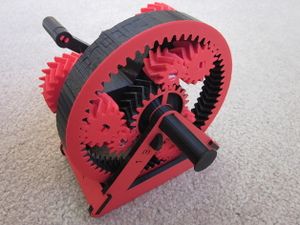User:Keevon7/Class Blog
Main | About Me | Class Blog
Weekly blog posts on topics stemming from 3D printing.
Contents
Blog 1: Thingiverse
Exploring Thingiverse to get acquainted with printed objects users had created.
A) Something Amazing/Beautiful
I thought this Halo 4 Full Size Helmet was awesome for a number of reasons. Aside from the beautiful detail, I was impressed by the intricate design, as well as the large overall size and functionality. To have the patience to make all of the components and have a fantastic final product is quite an achievement. Personally, I would love to have one of these sitting in my apartments, or wear one around State College.
I also thought that this Low Poly Mask was a great creation. It reminded me of a guy fawkes mask originally, but has a really neat overall look to it. While it looks simple, the design and assembly look rather complex, but the finished product would be an awesome mask to wear around.
B) Something Funny or Strange
I had a good chuckle when I first saw this iPhone TV Stand. It seems like such a strange idea to develop for an iPhone, but is quite comical. If I used this, I would most likely keep it on my desk as a novelty. However, it could also act as an interesting phone holder while it charges. Also, the goofy smile on the front of the desk for the drawers is an added plus.
Growing up with a little rubber band gun as a kid that I loved shooting around the house, I thought this Crosslock 2.2 Hand Rubber-band Powered Crossbow was quite amusing as well. I also found this ironic to build since there has been more and more talk about the danger of 3D printing weapons and guns, and would be funny to have a harmless little pencil crossbow sitting around to play with.
C) Something Useless
I'm not sure why this Lounge Chair was created, but I found it to be a comical and useless piece. While it obviously wouldn't be a functional piece, it could be an interesting addition to sit on a desk or counter for display.
D) Something Useful
In terms of a very practical and useful design, these Cable Holders (Cable Clip) would be great for any office or desk. Organizing wires and cables can help minimize clutter with this simple solution, and also improve the functionality of a work space. In an office setting, it would benefit the employee's efficiency and show professionalism by being neat and organized.
E) Something Surprising
I have been impressed with and surprised by how complex systems can be created through 3D printing like the Automatic Transmission Model. It is fascinating to see technology that can create an object which then results in a fully working assembly like an automatic transmission. I would be very interested in seeing how parts for manufacturing can be created and used within the coming years, and see if I could use this knowledge in my career down the road to reduce cost and improve efficiency. I see a lot of potential to benefit developing countries as well.
Blog 2: Open Source Ecology Project Discussion
A) Impression and External Information
Overall, I think this project is a very interesting concept, and could ultimately make a very positive impact in developing countries, and possibliy aid current farmers. It was great to hear about the many contributions added to this project from others once Marcin had made all his work public. While thinking about the future of this project, it does seem more and more that this open source community is similar to a utopian idea, but I’m concerned that selfish individuasl or large companies will buy out and suppress this type of material. For instance, open source technology like 3D printers can do an enormous amount of good, but if companies like MakerBot use this free information to make profit and halt development, the entire community suffers. Similarly, large companies like John Deere will be less than pleased if they see their products side by side with much cheaper alternatives, which could also threaten this venture. From a business standpoint, it would be common sense to prevent this community from growing, but selfish individuals who want to make a buck can also cripple this commendable project as well.
When I first saw all the machinery and some claims of simple assembly, I wanted to see how feasibly a project like the tractor would be to create. With regard to a farm or community, I felt the Mult-purpose Tractor seemed to be one of the most critical to have. After reading through the fabrication manual and drawings, it seemed like it would be challenging to do, but with plenty of time, energy, and patience, it could possibly be accomplished. Watching the assembly video on the wiki here helped visualize the process, but many of the explanations went right over my head. With little build experience to anything similar to this project, like the hosing portions for the loading arm cylinders or hydraulic drivelines, I feel that a skilled individual would be needed to complete this project. Certainly, with enough time the project could be completed, but in terms a quick start to a new community by building various machines, I personally don’t see it being that easy. Also, if some component would break during the process, with little understanding of how or why this tractor works, the lack of instruction manuals or troubleshooting tips could cripple the development of these machines as well.
Regardless of these concerns, after reading more about this project on their main website at http://blog.opensourceecology.org/, this project has been steadily growing since launch. I think it’s great that they have a full-time team of leaders willing to help the project, including project leads and operations managers to further propel the overall vision of the project (found here). With this added leadership, I do believe the open-source community concept can continue to grow in the coming years.
B) New Yorker and Marcin Response Articles
In an article by Emily Eakin of New Yorker Magazine (source), it seems more like a cynical critique of Marcin’s personal tendencies and ideology rather than reporting on the accomplishments of the project or future goals for self-sufficient communities. While I wouldn’t say it was necessary to discuses his journaling tendencies or mocking his food consumption, she did raise a point that had been a main hang up of mine. She had said in the article that, “…among the obstacles he has faced is a dearth of skilled acolytes: the people who show up at his farm typically display more enthusiasm for his ideas than expertise with a lathe or a band saw.” Personally, I would fall into that category. I have a lot of knowledge of how things should work mechanically and could offer some amount of enthusiasm, but honestly, my building skills and possibilities of innovation in these large designs are minimal.
Marcin had a response to this article on the Open Source Ecology (found here), and overall I thought it was a decent rebuttal to the article critical to his dream project. He had stated at the end of the article that, “I am proposing a much more optimistic representation of our work than the social melodrama that the article appears to emphasize.” Understandably, the leader and creator of the project would never focus on the issues their team is facing, but at some point his fervor and dream for the project may be blinding him to many issues that could prevent the success of these communities. I was again critical of his point about the “Big Hairy Audacious Goal” where he had stated “average people like myself” who would rise up to the occasion with measured development. Marcin, who has a Ph.D in fusion physics and years of creating machines and blueprints, is clearly an extremely smart guy. If by average he means people with exceptional skills in designs and years of building/manufacturing experience who happen to have the means to work on building a new community from scratch, then maybe I would believe him.
C) Capabilities at PSU
While there is a large amount of philanthropy here at Penn State for things like THON (which I also support), a project similar to a OSE club on campus could generate some interest, but I believe that they would run into issues similar to those that I was concerned about for the real projects with regard to the skills of the individuals interested. Sure, plenty of kids would want to help out communities, but with limited resources (poor college kids), current education/experience (book smart does not always translate to building machinery), and overall practicality (we live in an area full of working farms and communities), I'm skeptical of success. With regard to other courses like ME 340, sharing information would result in very similar projects across the board, and I feel this would ultimately limit creativity. That is something that professors and administration would not allow.
Blog 3: 3D Printed Prosthetic Hand
A) Who created this design and when/where was it done?
The article from The Kansas City Star was about a young man named Mason Wilde who had 3D printed a prosthetic hand for his 9-year-old family friend Matthew, who had been born without fingers on his right hand. Interestingly, the Robohand concept was originally developed by Ivan Owen and Richard Van As, who worked together to make a prosthetic for Van As after a workshop accident. In 2012, a woman from South Africa reached out to them about making a hand for her son after reading about their progress online, and a metal Robohand prototype was created. After refinement of this product to have parts not needed to be machined, a 3D printable version developed, and was available in January of 2013. Ultimately, this led to Wilde printing the Robohand at his local public library for roughly $60 dollars using a MakerBot printer. An official prosthetic device would have cost $18,000, but with the development and free instruction from Owan and Van As, many other have been able to benefit from their revolutionary work.
B) If you wanted to make one, where would you go to get it?
The article had referenced Thingiverse as a starting point, and the most useful link to create one was found here. With a few clicks of the mouse, one is able to download the various CAD files (.stl) associated with the Robohand to be printed. A video discussing this product further is found through the above Thingiverse page here, and features some encouraging clips of a few kids who are excited about having functioning Robohand prosthetics.
C) How many news articles can you find which reference this technology?
The following articles were published with regard to Robohand technology:
PC Magazine - Article
Time - Article
MakerBot - Article
American Society of Mechanical Engineers - Article
CBS News - Article
Huffington Post - Article
Blog 4: Review of Classmate and Team Blog Posts on OSE Project
Upon reading through some of my classmate’s blogs about the open source ecology project, as well as those written by my teammates, I agreed with many of their ideas, but also was impressed by a number of excellent points that were raised that I had originally missed.
I enjoyed reading through Carson’s post on the OSE project since it was far more optimistic than my more cynical stance. Upon more reflection, I was challenged by my teammate’s post since I was far more critical of Marc’s vision due to the common pitfalls of human nature, and therefore didn’t take his talk on the project and related material as seriously as I could have. Where I had thought this was more a of a vanity project to show off his brilliant work, Carson took it more as having a heart for underdeveloped countries, which is more than likely why he started this project in the first place.
One obvious issue that I hadn’t elaborated on was the safety aspects of these build projects, which were brought up by my teammate Oliver. While they are making awesome machinery like tractors for minimal costs, there is a balance between safety and efficiency. I learned within my ME 445 microcontrollers class that there is a lot of added work and programming involved with tractors to prevent rollover and other dangerous risks to operators. This raises a number of red flags about theses projects, on top of the dangerous mechanical and electrical work, but also the overall safety of the machinery for users. Sure, this machinery has seat belts, but that won’t save you from being crushed or electrocuted in a mishap.
Tom, another teammate of mine, also brought up an excellent point with regard to available materials for these various start up locations to begin with. He had mentioned materials like wood or rubber could be extremely difficult to begin a “civilization start-up” without. Starting materials and necessary tools are a linchpin for the projects due to the obvious reason that even if you have plans laid out on how to build a civilization, it won’t get past the planning period without basic tools and resources. If you wanted to build a tractor to benefit a community, but didn’t have access to rubber tires or specific metal components, how can any progress be made?
Similarly to Tom’s discussion about starting projects, my fourth teammate Vin elaborated on the added costs for maintenance. Not only will it be somewhat difficult to complete these projects unless you have easy access to a store like Home Depot, there is additional cost on top of the initial costs of gathering materials to maintain the machinery. I had touched on this topic with concern to what would happen if something broke and the users were unable to understand how to fix it. Vin took this thought a step further, and also considered the financial ramifications. The unexpected maintenance costs could be what cripples a project if enough funding is gathered to build instead of maintaining equipment. Similarly, Zach had mentioned another obvious downfall, which would be access to computers and Internet to read the wiki and associated instructional material. If locations have issues of gaining basic materials, a web-based resource may not be the most ideal platform.
Originally, I had not read the entire New Yorker due to only a portion of it was available without having to pay, and Eva mentioned this point ironically since this news source could learn something from the “open source community” by allowing us to access it. When I continued reading the full version of the article, I was just as disenchanted as I was before due to the hyper critical stance of Marc instead of discussing the OSE project as much as it should have.
With regard to my critical stance, I agreed with a majority of what Dongao had discussed. As for the overly complex designs, I agreed with Dongao that these aren’t easily as shared open source technology like 3D printing of CAD models that can be scaled. A small .stl file can be easily shared and understood, but can the same be said for large farming equipment that require mechanical, electrical, and welding experience to build?
As for a more optimistic standpoint, I had been reading through a few different posts from classmates, and I thought it was interesting that Nam had even mentioned building some of this machinery. I had tried to read through the detailed drawings and instructional videos, but was often lost. It would be really neat to have a fellow classmate work on and complete a piece of machinery from this project, and would be an individual that could greatly help the OSE project with his hard work.
One last aspect that I found quite interesting was with Nate's blog and associated background with farming. He is from Lancaster, Pa, and has seen the financial strain on farmers, and sees this topic from very unique stance due to his background growing up on a small farm. Benefiting farmers is one aspect that I had originally overlooked, and the more I think about it, the more I could get on board with the project if it could help local farmers. As someone who has as respect for a farmer’s way of life and hard work, if this OSE project can lighten the financial burden on farms, I would definitely support it.
Blog 5: Media Timeline Review
I found it extremely interesting that 3D printing and advancements dated all the way back to the mid 80’s. From my own experience, I hadn’t heard of rapid prototyping for 3D printing until my freshman year in 2010, so I was quite surprised this technology has been out there for so long after reviewing the media timeline found on the Scrugmembers page.
1) With regard to a critical even in 3D printing technology, I would say Charles Hull’s development of technology to print 3D objects using stereolithography and digital data was most likely the largest contribution thus far. The method of using a photosensitive polymer that hardens when exposed to high intensity light is still prevalent today, and is often used in molding casts. Interestingly, the same progression of adding one layer at a time is still replicated almost thirty years later within various forms of 3D style printers. Another aspect that blew me away was the processing of CAD files. Not only were .stl files used, but were also spliced to be able to print various parts (different .stl files), as well as z-direction controls to account for waiting time. I’m astounded that the same method developed years before I was born is still so prevalent and functional. While some aspects are different for our purposes, like the mirrors to control the x-y directions, this was an amazing breakthrough that launched the world of 3D printing that is around today. If I could bestow titles, I would name Charles Hull as the father of 3D printing.
2) As for a not so important event, I would say the CNN article from 2005 is a bit of an overhyped looked at 3D printing with the bold title of “the machine that can copy anything,” and doesn’t elaborate on the open source community aspect as much as it could have. I understand that you need to draw readers in with a catchy title, and “3D printing developments with RepRap community” doesn’t sound as exciting, the title seems to over exaggerate the printer’s abilities. Even if this were published today, roughly 9 years later, I would still argue it’s an exaggeration of the current capabilities. While I found the article didn’t relate to the title, it was fortunate that the 3D printing developments and technology were publicized. The portion mentioning that Bowyer had planned to make designs available online using RepRap was a huge step for the 3D printing community. Just from looking at the media timeline since the article’s release, there has been an exponential growth and breakout of 3D technology. As it had been discussed in class, the reason we can have an awesome class like EDGSN 497J is due to an open community of users that contribute to the greater overall good.
3) The most interesting aspect I had read about was the possibilities to print other types of materials like food or composite materials using 3D printing capabilities. From the “Foodini” that can has the ability to lay down dough and sauce to make pizzas, or printers capable printing things like meat, these are interesting and innovative process that I would love to learn about and develop further. Aside from the possible benefits from a manufacturing setting to create food on an industrial scale, thinking of the benefits for humanity are huge. For me personally, I would much rather support a project that could get 3D printers to impoverished countries for the purpose of creating food for those in need. For instance, I recently watched a documentary in Syria, and both refuges and civilians are struggling to get enough food during the dangerous conflict. Many of them still had cell phones and computers, but couldn’t safely gather the ingredients necessary to make things as simple as bread. These printers could be used to help them make a variety of food at a single location easily, and also help rebuild their country through printing strong materials to print tools. This topic would be something I would enjoy talking about and discussing further since there is so much potential to help other countries with this technology. Printers with these new and interesting capabilities will continue to be in the news, and hopefully many more developments within this field will come to fruition to benefit many communities across the world.
Blog 6: Project Discussion
The more I have learned about 3D printing capabilities, the more I appreciate the merit and beneficial impacts for society. From projects like the OSE project that can jump start communities, to creations like prosthetics to improve the quality of living for many individuals, the number of possible worthwhile projects is limitless. Personally, the topic that I am most excited about is 3D printing capabilities of food, and ways that this could potentially help individuals around the globe as a project.
I have seen a lot of talk of benefiting third world countries with 3D printing capabilities and technology, but many of the areas that are often considered don’t have ample resources like internet, electricity, or phone service, which is very disheartening. All of the valuable wiki pages and instructional videos to sustain 3D printing in foreign nations would be largely unavailable. While this is very frustrating limitation, this had sparked personal interest in seeing where this technology could be implemented in areas or countries where there aren’t limitations due to technology. Two countries that come to mind immediately are Syria and Ukraine, who have been in the news constantly due to internal conflicts within their countries.
For me personally, I feel a connection towards Ukraine since some of my family had immigrated to the U.S. during the Bolshevik Revolution. When I see the protests and conflicts in the news with young men and woman my age on the front lines, I can’t help but think that I could’ve been one of them had I not been born here in the U.S. Similarly, I watched a documentary about the conflict in Syria, and one of the individuals who was interview and injured a few times fighting the army could’ve passed for a relative due to our similar features. In both instances, I felt a connection to these individuals in challenging situations, and since I have been blessed being born in Pennsylvania and able to get a great education at PSU, sharing 3D printing technology to help these countries rebuild would be a worthy venture.
A key aspect to each of these areas is that they have cell phone and Internet availability, as well as computer access. With this technology, they could reap the full benefits of the wiki’s we have maintained, just after some leg work to convert all of our English write-ups to their respective language for ease. Within the Syria documentary, refugees from all across the company are fleeing, and ending up in small towns that can’t sustain themselves. They can’t harvest their crops or else they would be shot at and potentially killed. Food shortages are rampant, but if 3D printers could be implemented and regulated with citizens, foods like bread can be printed safely inside of house. Admittedly, there are a lot of factors like how to get the printers there, how to ensure they are only used to print goods, and maintenance, if a thorough wiki was developed for these types of printers, we could be saving civilian lives.
Printing food is something that is just within our reach of where we are currently. I feel like a majority of the class is comfortable with the basic trouble shooting and assembly of our current printers, and the transition into food printing capabilities could be a reasonable venture to pursue as a project. One enhancement that I had thought of was expanding upon the trouble shooting section on the wiki, or even suggestions too look out for potential issues users encounter. For instance, instructional steps to resolve common problems like stepper motors slipping or axis correction could be a huge benefit in moving forward with other technologies if the class makes a conscience effort to add these suggestions to the wiki. Ultimately, if there is enough interest and effort, I believe developing 3D printers with food capabilities and subsequent information could be a viable option to pursue.
Blog 7: Developing Inexpensive Scientific Equipment
In an article by The Guardian, the topic of developing inexpensive scientific equipment that could be created using 3D printing capabilities was discussed. While I originally found the title and heading a bit vague, and the picture rather misleading since it was totally unrelated to the article, I think this idea of saving money for research and opening the capabilities to a large audience are commendable.
One example they gave in the article was a 3D printer colorimeter used for water testing, which would originally cost $2,000 dollars, but could instead be printed for $50. With regard to research and the uses for developing countries, this is a fantastic advancement. In a University setting, instead of using a bulk of funding to purchase a small piece of equipment, an exponentially cheaper product could be available, which would increase the number of possible tests and still save funds. For developing countries, useful technology like water pumps or gyroscopes can be created easily at little cost. From an individual and humanitarian standpoint, this is a great development, but as for the companies manufacturing these good, this idea is less than desirable.
Within the article, Pearce had stated that, “companies relying on extracting monopoly prices on products for which there is already an equivalent open-source alternative must either reduce their margins or continue to innovate to remain economically viable.” From that standpoint, it seems to accuse businesses of making absurd profits, or improve or refine their products to compete with these little producers. Like most of these projects, while I root for the underdog, I am always concerned that big business will be tired of small ventures like, and either buy them out, or sue them into submission. It only takes one individual to turn to a major company for a huge settlement, and the open source community is crippled.
While I’m not entirely sure the components for other printers we create using the current 3D printers would count as research equipment, the subsequent printers and capabilities of the materials we print could definitely be considered research equipment. For example, Alexandre had printed various materials to test tensile strength, and a majority of his research and work stemmed from printable creations that enhanced our current designs. As for of the cheap research equipment, I had some experience as a lab tech in high school, and materials like pipette components or trays/dishes could be easily printed. Another aspect that I hadn’t considered is how easily it would be to print various sizes of objects like Petri dishes. Whether it is square or circular, the different sizes and spec can be changed in seconds within a CAD file, and subsequently printed with ease. Instead of the stress of only having limited and breakable equipment that needs to be shipped in, any size or shape you would require could be printed quickly for little cost.
